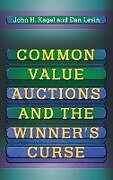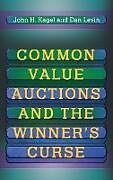Common Value Auctions and the Winner's Curse
Einband:
Fester Einband
EAN:
9780691016672
Untertitel:
Englisch
Genre:
Sonstiges
Autor:
John H. Kagel, Dan Levin
Herausgeber:
Princeton University Press
Anzahl Seiten:
424
Erscheinungsdatum:
11.08.2002
ISBN:
978-0-691-01667-2
"This book shows that the kind of winner's curse at issue is pervasive across various types of auctions and is not eliminated by experience or even by using expert bidders. One of its main contributions is the specification of naïve bidding models that explain patterns of deviations from (Nash) theoretical predictions. The ex post perspectives about how to improve experimental designs and procedures for dealing with bankruptcies were particularly interesting."Charles A. Holt, University of Virginia
Autorentext
John H. Kagel is University Chaired Professor of Applied Economics and director of the Economics Laboratory at Ohio State University. A leading economic theorist, he is coeditor of, and a contributor to, The Handbook of Experimental Economics (Princeton). Dan Levin is professor of economics at Ohio State University. He has published numerous articles on competitive bidding and industrial organization in leading economic journals.
Klappentext
An invaluable account of how auctions work-and how to make them work Few forms of market exchange intrigue economists as do auctions, whose theoretical and practical implications are enormous. John Kagel and Dan Levin, complementing their own distinguished research with papers written with other specialists, provide a new focus on common value auctions and the "winner's curse." In such auctions the value of each item is about the same to all bidders, but different bidders have different information about the underlying value. Virtually all auctions have a common value element; among the burgeoning modern-day examples are those organized by Internet companies such as eBay. Winners end up cursing when they realize that they won because their estimates were overly optimistic, which led them to bid too much and lose money as a result. The authors first unveil a fresh survey of experimental data on the winner's curse. Melding theory with the econometric analysis of field data, they assess the design of government auctions, such as the spectrum rights (air wave) auctions that continue to be conducted around the world. The remaining chapters gauge the impact on sellers' revenue of the type of auction used and of inside information, show how bidders learn to avoid the winner's curse, and present comparisons of sophisticated bidders with college sophomores, the usual guinea pigs used in laboratory experiments. Appendixes refine theoretical arguments and, in some cases, present entirely new data. This book is an invaluable, impeccably up-to-date resource on how auctions work--and how to make them work.
Zusammenfassung
An invaluable account of how auctions workand how to make them work
Few forms of market exchange intrigue economists as do auctions, whose theoretical and practical implications are enormous. John Kagel and Dan Levin, complementing their own distinguished research with papers written with other specialists, provide a new focus on common value auctions and the "winner's curse." In such auctions the value of each item is about the same to all bidders, but different bidders have different information about the underlying value. Virtually all auctions have a common value element; among the burgeoning modern-day examples are those organized by Internet companies such as eBay. Winners end up cursing when they realize that they won because their estimates were overly optimistic, which led them to bid too much and lose money as a result.
The authors first unveil a fresh survey of experimental data on the winner's curse. Melding theory with the econometric analysis of field data, they assess the design of government auctions, such as the spectrum rights (air wave) auctions that continue to be conducted around the world. The remaining chapters gauge the impact on sellers' revenue of the type of auction used and of inside information, show how bidders learn to avoid the winner's curse, and present comparisons of sophisticated bidders with college sophomores, the usual guinea pigs used in laboratory experiments. Appendixes refine theoretical arguments and, in some cases, present entirely new data. This book is an invaluable, impeccably up-to-date resource on how auctions work--and how to make them work.
Inhalt
Preface xiii Credits xv Chapter 1. Bidding in Common Value Auctions: A Survey of Experimental Research by John H. Kagel and Dan Levin 1 1. An Initial Experiment Demonstrating the Winner's Curse 4 Chapter 2. Sealed-Bid Auctions 5 2.1 Theoretical Considerations: First-Price Sealed-Bid Auctions 6 2.2 Some Initial Experimental Results: Inexperienced Bidders 7 2.3 Auctions with Moderately Experienced Bidders and the Effects of Public Information on Sellers' Revenue 7 2.4 Is the Winner's Curse a Laboratory Artifact? Limited Liability for Losses 13 2.5 Second-Price Sealed-Bid Auctions 16 2.6 Group versus Individual Bids 20 2.7 Summing Up 22 3. English Auctions and First-Price Auctions with Insider Information 23 3.1 English Auctions 24 3.2 Auctions with Insider Information 27 4. The Winner's Curse in Other Settings 33 4.1 The Winner's Curse in Bilateral Bargaining Games 33 4.2 The Winner's Curse in "Blind-Bid" Auctions 36 4.3 Lemons and Ripoffs: The Winner's Curse in Markets with Quality Endogenously Determined 39 4.4 The Swing Voter's Curse 40 4.5 Summing Up 46 5. How Do Bidders Learn to Overcome the Winner's Curse? 47 5.1 Bilateral Bargaining Games 47 5.2 Inexperienced Bidders in Sealed-Bid Auctions 48 5.3 Super-Experienced Bidders in Sealed-Bid Auctions 51 5.4 The Role of Information Feedback on Learning 52 6. Comparing Results from Field Studies with Experiments 53 6.1 Direct Comparisons between Laboratory and Field Data 56 6.2 Differences in Structure between Laboratory and Field Auctions 58 6.3 Summing Up 60 7. Concluding Remarks 60 7.1 Summary of Empirical Findings from the Laboratory 60 7.2 Theory Motivated by Experiments 62 7.3 Auction Theory and Experiments at Work: Airwave Rights Auctions 65 8. Overview of What Follows 66 Chapter 2. First-Price Common Value Auctions: Bidder Behavior and the "Winner's Curse" by John H. Kagel, Dan Levin, Raymond C. Battalio, and Donald J. Meyer 85 1. Introduction 85 2. Structure of the Auctions 86 3. Theoretical Considerations and the Winner's Curse 87 4. Experimental Results 89 4.1 Market Outcomes 89 4.2 Individual Bidding Behavior over Time 93 5. Summary and Conclusions 100 Appendix: Inexperienced Bidders in Second-Price Common Value Auctions 101 Notes 104 References 105 Chapter 3. The Winner's Curse and Public Information in Common Value Auctions by John H. Kagel and Dan Levin 107 1. Structure of the Auctions 108 1.1 Basic Auction Structure 108 1.2 Auctions with Public Information 112 1.3 Varying Numbers of Bidders 113 1.4 The Experience Factor 113 2. Theoretical Considerations 114 2.1 Private Information Conditions 114 2.2 Effects of Public Information 116 2.3 Summary of Research Questions of Primary Interest 118 3. Experimental Results 119 3.1 Bidding Patterns with Private Information 119 3.2 Effects of Public Information on Seller's Revenues 127 3.3 Summary of Experimental Outcomes of Primary Interest 131 4. Toward Generalizability: But Is This How the Real World Operates? 131 5. Conclusions 134 Notes 136 References 140 Addendum: Benchmark Equilibrium for First-Price Auctions with Public Information 141 Chapter 4. Comparative Static Effects of Number of Bidders and Public Information on Behavior in Second-Price Common Value Auctions by John H. Kagel, Dan Levin, and Ronald M. Harstad 149 1. Introduction 149 2. Structure of the Auctions 152 2.1 Basic Auction Structure 152 2.2 Auctions with Public Information 152 2.3 Subject Experience and Varying Numbers of Bidders 153 3. Theoretical Considerations 154 3.1 Naive Bidding under Private Information Conditions: A Model of the Winner's Curse 154 3.2 Nash Equilibrium Bidding und…

Leider konnten wir für diesen Artikel keine Preise ermitteln ...
billigbuch.ch sucht jetzt für Sie die besten Angebote ...
Die aktuellen Verkaufspreise von 5 Onlineshops werden in Realtime abgefragt.
Sie können das gewünschte Produkt anschliessend direkt beim Anbieter Ihrer Wahl bestellen.
Loading...
Die aktuellen Verkaufspreise von 5 Onlineshops werden in Realtime abgefragt.
Sie können das gewünschte Produkt anschliessend direkt beim Anbieter Ihrer Wahl bestellen.
| # | Onlineshop | Preis CHF | Versand CHF | Total CHF | ||
|---|---|---|---|---|---|---|
| 1 | Seller | 0.00 | 0.00 | 0.00 |
